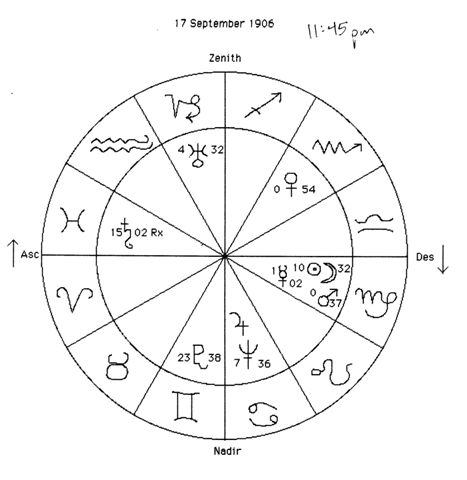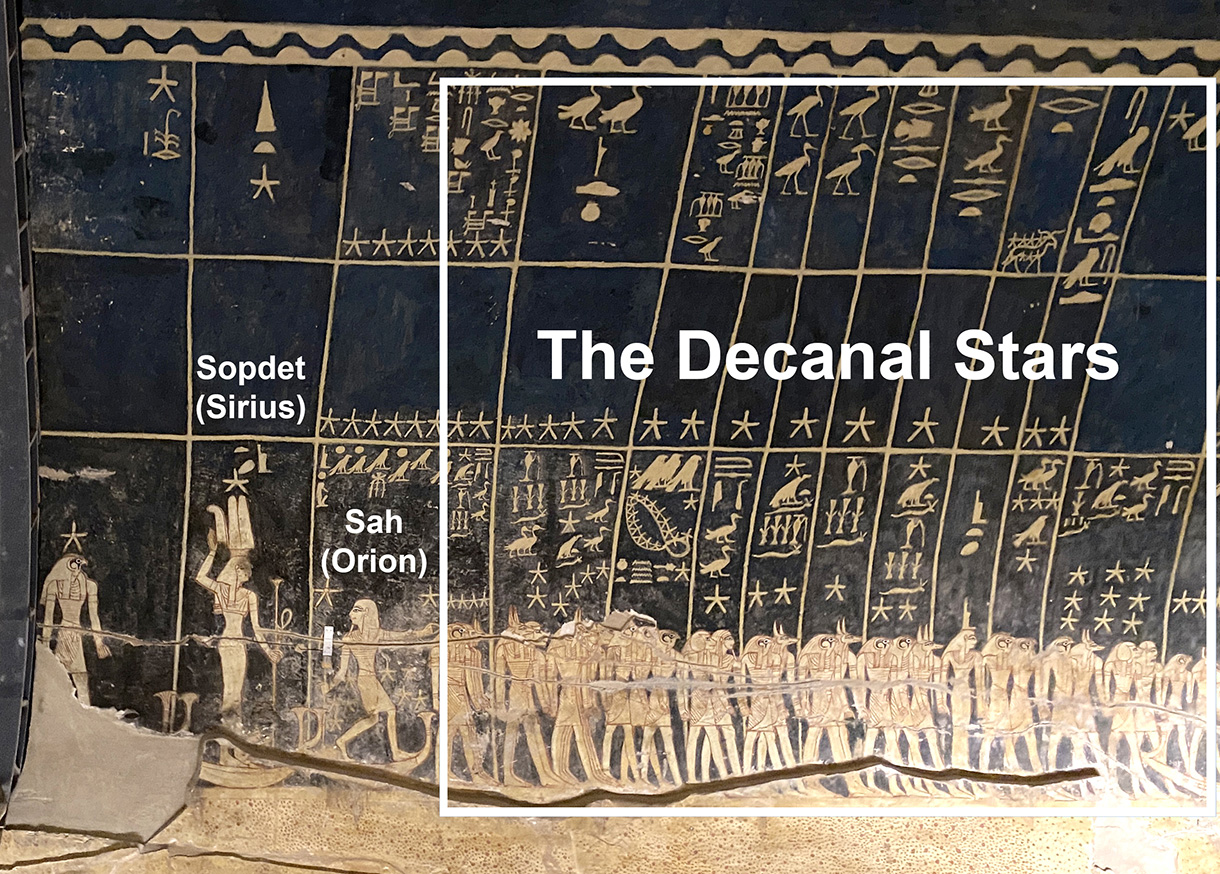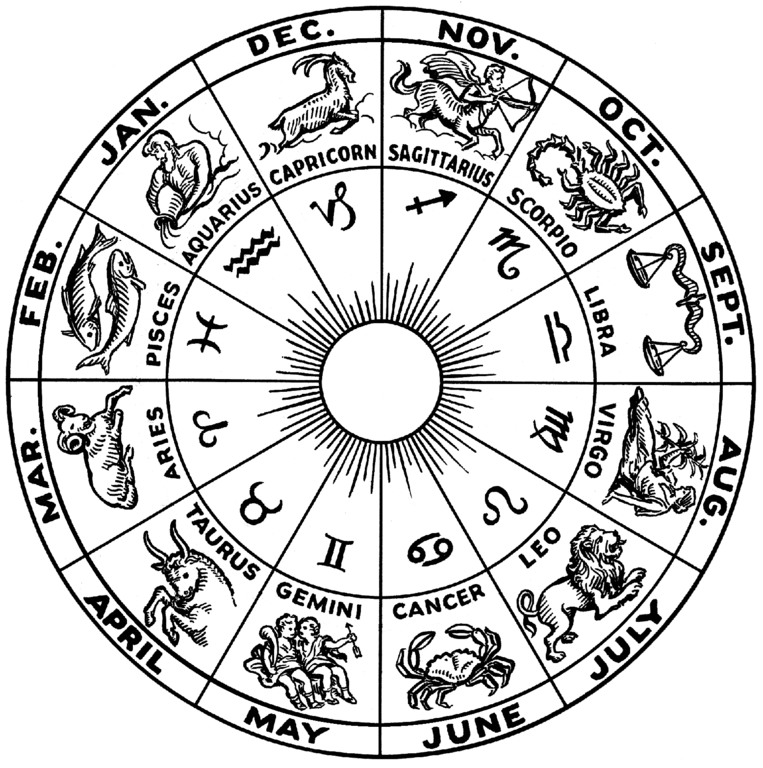Horoscope

A horoscope is an astrological chart or diagram representing the positions of the Sun, Moon, planets, astrological aspects and sensitive angles at the time of an event, such as the moment of a person's birth.
The word "horoscope" is derived from the Greek words ōra and scopos meaning "time" and "observer" (horoskopos or "marker(s) of the hour"). It is claimed by proponents of astrology that a horoscope can be used as a method of divination regarding events relating to the point in time it represents, and it forms the basis of the horoscopic traditions of astrology.
Among the mainstream media, horoscope columns are often featured in print and online newspapers.
History
Horoscopic astrology as practiced in the Western world has undergone a long evolution which originated in Egypt, Greece, and Persia and is predominantly a mixture of the astrological systems used by these three cultures.
The ancient Egyptians created a system for observing the night sky and divided it into 36 parts called decans, which first appeared in the 10th Dynasty (2100 BCE) on coffin lids found in tombs of noblemen in the region of Asyut. The sequence of these star patterns began with Sopdet, the star Sirius, and each decanal star had a corresponding deity. As measures of time, the rising and setting of decans marked 'hours' and groups of 10 days which comprised an Egyptian year. The sequence of decans on the inside of coffin lids is not entirely understood by Egyptologists, but there is growing consensus that these patterns were customized for each person inside the coffin and may have served as an early form of horoscope. This theory is validated by the later use of horoscopes on the interior lids of coffins during the Hellenistic Period when Egypt was under Greek rule.
Separately from the Egyptian astrological tradition, Babylonian astrology began to study the sky and record omens of the future around 1800 BC. Babylonian astrologers divided the night sky into 12 signs, which are nearly identical to the modern tropical zodiac. The first, undisputed personalized horoscope created to divine the future of a person was written in Persia in 408 BC, only four years after the Persian conquest of Egypt.
After Alexander the Great invaded Egypt, Egyptian astrology melded with Greek and Persian astrology and the original system of decans gave way to a lunar division of 27 or 28 lunar stations, also known as manzil (lunar mansions) and to a zodiac of 12 signs, based on an anthropomorphic pattern of constellations, and their use can be seen in the Dendera zodiac dated to circa 50 BCE.
Throughout the Graeco-Roman Period, personalized horoscopes were extremely popular, a practice which persisted throughout the Middle Ages. During the Medieval Period, although astrological skills remained in high demand, there were serious penalties for casting horoscopes of Christian monarchs. Magician Roger Bolingbroke was sentenced to death for casting a horoscope for King Henry VI. Richard III had his brother, the Duke of Clarence sentenced to death for ordering a horoscope of King Edward. John Dee was arrested for casting a horoscope for Queen Mary I of England. In the 1500s, French astrologer Nostradamus was careful to conceal his predictions with cryptic wording to avoid charges of treason or heresy.
Fundamental concepts
The horoscope serves as a stylized map of the heavens over a specific location at a particular moment in time. In most applications the perspective is geocentric. The positions of the actual planets (including Sun and Moon) are placed in the chart, those of purely calculated factors such as the lunar nodes, the house cusps including the midheaven and the ascendant, zodiac signs, fixed stars and the lots. Angular relationships between the planets themselves and other points, called aspects, are typi, including weakness.
- The native is the subject of the event (a birth, for example) being charted at a particular time and place, and is considered to be at the centre of the celestial sphere.
- The celestial sphere is an imaginary sphere onto which the zodiac, constellations and planets are projected.
- The plane of the equator is the plane of the Earth's equator projected into space.
- The plane of the ecliptic is defined by the orbits of the earth and the sun. For practical purposes the plane of the equator and the plane of the ecliptic maintain a constant inclination to each other of approximately 23.5°.
- The plane of the horizon is centred on the native and is tangential to the earth at that point. In a sphere whose radius is infinitely large, this plane may be treated as nearly equivalent to the parallel plane with its centre at the Earth's center. This greatly simplifies the geometry of the horoscope but does not take into account that the native is in motion. Some writers on astrology have thus considered the effects of parallax, but most would agree that (apart from that of the moon) they are relatively minor.
Use of the Zodiac
The Zodiac, or "circle of animals" is a zone or belt in space projected onto the celestial sphere through which, from our viewpoint, the planets move. A symbolic geometric construction around 16 degrees wide, it is divided into 12 signs, each of 30 degrees longitude (making 360 degrees, a full circle), with the ecliptic, the apparent path of the Sun, as its middle line.
The tropical zodiac used by most Western astrologers has its beginning at the exact moment that the Sun crosses the celestial equator and enters the zodiacal sign of Aries. Some Western astrologers use the sidereal zodiac favored by Indian astrologers, which is based more closely on actual positions of constellations in the heavens, as opposed to the tropical zodiac, which is a moveable format based on the seasons.
The tropical zodiac defines the vernal point (the first day of spring in the northern hemisphere) as the first degree of Aries, but the sidereal zodiac allows it to precess. Many people are confused regarding the difference between the sidereal zodiac and the tropical zodiac signs. Because of a "wobble" in the Earth's axis of rotation over a period of about 26,000 years (often called a "great year"), the rate at which the vernal equinox precesses in the heavens is approximately 0 deg, 0 min, 50.23 seconds a year, drifting by one degree every 72 years. Precession of the equinoxes thus occurs at a rate of roughly 5 arc minutes of a degree every 6 years. The tropical signs relate to the seasons and not the stars. Here is an example: a person born on, say August 28, 2002, would come to understand that their Sun sign was in Virgo according to Western astrology (conventional Sun sign dates August 23, to September 22, of every year), but the Sun on that same calendar date of the year 2002 was in the constellation Leo (where it had been since August 10, 2002, and would remain until September 15, when it would then finally cross into Virgo).
The sidereal signs and the tropical signs are both geometrical conventions of 30° each, whereas the zodiacal constellations are pictorial representations of mythological figures projected onto the celestial sphere based on patterns of visible star groupings, none of which occupy precisely 30° of the ecliptic. So constellations and signs are not the same, although for historical reasons they might have the same names.
Some astrologers do not use the signs of the zodiac at all, focusing more instead on the astrological aspects and other features of the horoscope. The sun sign is the sign of the zodiac in which the sun is located for the native. This is the single astrological fact familiar to most people. If an event occurs at sunrise the ascendant and sun sign will be the same; other rising signs can then be estimated at two-hour intervals from there. A cusp is the boundary between two signs or houses. For some, the cusp includes a small portion of the two signs or houses under consideration.
Criticisms
There are no scientific studies that have shown support for the accuracy of horoscopes, and the methods used to make interpretations are considered to be examples of pseudoscience. In modern scientific framework no known interaction exists that could be responsible for the transmission of the alleged influence between a person and the position of stars in the sky at the moment of birth.
Although it has its proponents, astrology has been rejected by the scientific community because astrology has no verifiable mechanism behind it. Many practitioners of astrology claim that astrology is indeed a science however, despite many trial and experiments, the effectiveness and scientific evidence of astrology is still yet to be demonstrated.
Christian criticism
In Christianity, many say that people should not use horoscopes or practice astrology in general, citing Deuteronomy 4:19, Deuteronomy 18:10-12, and Isaiah 47:13-14 from the Bible. Evangelist and minister Billy Graham has said, "God did make the stars (as well as everything else in the universe), but he intended them to be a witness to his power and glory, not as a means to guide us or foretell the future."
Despite contemporary Christian criticism, astrology was practiced widely in Biblical times and the three Wise Men, or Magi, are often considered to have been astrologers who used the “movement of the stars” to guide them to the manger where Jesus Christ was born.

